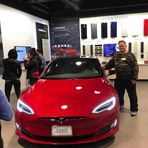Market Whirlwinds: Trump, Musk, and the Dance of Investor Sentiment
April 23, 2025, 4:40 pm

Location: United States, Texas, Austin
Employees: 10001+
Founded date: 2003
Total raised: $3.86B
In the world of finance, the winds can shift in an instant. A single statement can send stocks soaring or plummeting. Recently, the U.S. markets experienced a jolt of optimism, fueled by comments from President Donald Trump and Treasury Secretary Scott Bessent. Their reassurances provided a glimmer of hope amid a backdrop of economic uncertainty.
Trump declared he has “no intention” of firing Federal Reserve Chair Jerome Powell. This declaration was music to investors' ears. Powell's leadership is crucial for maintaining stability in the economy. When a president expresses confidence in the Fed, it’s like a lighthouse guiding ships through a storm. The markets responded positively, with the S&P 500 rising 2.51%, the Dow Jones up 2.66%, and the Nasdaq climbing 2.71%.
Bessent added fuel to the fire, suggesting a potential de-escalation in the ongoing trade war with China. His comments hinted at a thaw in relations, which many see as vital for economic recovery. The notion that both sides recognize the unsustainability of the current status quo is a beacon of hope. Investors are always on the lookout for signs of easing tensions, and Bessent’s words were like a fresh breeze, lifting spirits across the trading floor.
However, the optimism was not without its shadows. Tesla, the electric vehicle giant led by Elon Musk, reported disappointing first-quarter earnings. Revenue fell 9% to $19.34 billion, and net income plummeted 71%. This was a stark reminder that even in a buoyant market, reality can bite. Despite the earnings miss, Tesla shares surged over 5% in after-hours trading. Investors seemed to latch onto Musk’s announcement that he would spend “significantly” less time at DOGE, his government role. It’s a classic case of investors choosing to focus on the silver lining rather than the storm clouds.
Yet, the broader sentiment about Musk and Tesla is shifting. A recent survey revealed that more than 47% of Americans view Tesla negatively, a stark contrast to General Motors, which sits at just 10%. Musk himself is not immune to this scrutiny, with around half of respondents expressing disapproval of him. In the world of finance, reputation is a fickle friend. While markets may react quickly to positive news, the underlying perceptions can linger like a stubborn fog.
As the U.S. dollar falters, investors are flocking to safe-haven currencies. An exchange-traded fund linked to one such currency surged 8% in April, reflecting a broader trend of caution among investors. The dollar’s decline is a siren call for many, urging them to seek refuge in more stable assets. Paul Feinstein, CEO of Audent Global Asset Management, described this currency as “one of the most enduring safe havens.” In uncertain times, safety becomes paramount.
The backdrop of regulatory scrutiny is another layer in this complex tapestry. Increased oversight of U.S.-listed Chinese firms has sparked fears of delistings. The potential for hundreds of billions of dollars to flow out of the market adds a layer of anxiety. The SEC’s ability to enforce compliance with audit requests has put many companies on edge. This regulatory environment is like a storm brewing on the horizon, threatening to disrupt the delicate balance of the markets.
The trade war’s impact is also becoming evident in the shipping industry. A steep drop in freight traffic from China to major U.S. ports signals a tightening grip of tariffs and economic fears. Container vessel traffic to Los Angeles and Long Beach has plummeted, with a 29% week-over-week decline. Year-over-year, the numbers are even more alarming, showing a 44% drop. This decline in trade is a stark reminder of the interconnectedness of global economies. When one link weakens, the entire chain feels the strain.
In the face of these challenges, the markets remain a paradox. They can be buoyed by optimism one moment and dragged down by reality the next. The interplay between Trump’s reassurances, Musk’s mixed signals, and the looming specter of regulatory scrutiny creates a volatile environment. Investors are like tightrope walkers, balancing between hope and fear.
As we look ahead, the path remains uncertain. Will the optimism surrounding Trump and Bessent translate into sustained market growth? Or will Tesla’s struggles and regulatory fears cast a long shadow? The answers lie in the delicate dance of investor sentiment. In this world, every word carries weight, and every decision can tip the scales. The markets are a living organism, constantly evolving, always reacting.
In conclusion, the current landscape is a testament to the unpredictable nature of finance. It’s a world where optimism can reign, but caution is always warranted. As we navigate these turbulent waters, one thing is clear: the dance of the markets is far from over. Investors must remain vigilant, ready to adapt to the ever-changing rhythm of the economic symphony.
Trump declared he has “no intention” of firing Federal Reserve Chair Jerome Powell. This declaration was music to investors' ears. Powell's leadership is crucial for maintaining stability in the economy. When a president expresses confidence in the Fed, it’s like a lighthouse guiding ships through a storm. The markets responded positively, with the S&P 500 rising 2.51%, the Dow Jones up 2.66%, and the Nasdaq climbing 2.71%.
Bessent added fuel to the fire, suggesting a potential de-escalation in the ongoing trade war with China. His comments hinted at a thaw in relations, which many see as vital for economic recovery. The notion that both sides recognize the unsustainability of the current status quo is a beacon of hope. Investors are always on the lookout for signs of easing tensions, and Bessent’s words were like a fresh breeze, lifting spirits across the trading floor.
However, the optimism was not without its shadows. Tesla, the electric vehicle giant led by Elon Musk, reported disappointing first-quarter earnings. Revenue fell 9% to $19.34 billion, and net income plummeted 71%. This was a stark reminder that even in a buoyant market, reality can bite. Despite the earnings miss, Tesla shares surged over 5% in after-hours trading. Investors seemed to latch onto Musk’s announcement that he would spend “significantly” less time at DOGE, his government role. It’s a classic case of investors choosing to focus on the silver lining rather than the storm clouds.
Yet, the broader sentiment about Musk and Tesla is shifting. A recent survey revealed that more than 47% of Americans view Tesla negatively, a stark contrast to General Motors, which sits at just 10%. Musk himself is not immune to this scrutiny, with around half of respondents expressing disapproval of him. In the world of finance, reputation is a fickle friend. While markets may react quickly to positive news, the underlying perceptions can linger like a stubborn fog.
As the U.S. dollar falters, investors are flocking to safe-haven currencies. An exchange-traded fund linked to one such currency surged 8% in April, reflecting a broader trend of caution among investors. The dollar’s decline is a siren call for many, urging them to seek refuge in more stable assets. Paul Feinstein, CEO of Audent Global Asset Management, described this currency as “one of the most enduring safe havens.” In uncertain times, safety becomes paramount.
The backdrop of regulatory scrutiny is another layer in this complex tapestry. Increased oversight of U.S.-listed Chinese firms has sparked fears of delistings. The potential for hundreds of billions of dollars to flow out of the market adds a layer of anxiety. The SEC’s ability to enforce compliance with audit requests has put many companies on edge. This regulatory environment is like a storm brewing on the horizon, threatening to disrupt the delicate balance of the markets.
The trade war’s impact is also becoming evident in the shipping industry. A steep drop in freight traffic from China to major U.S. ports signals a tightening grip of tariffs and economic fears. Container vessel traffic to Los Angeles and Long Beach has plummeted, with a 29% week-over-week decline. Year-over-year, the numbers are even more alarming, showing a 44% drop. This decline in trade is a stark reminder of the interconnectedness of global economies. When one link weakens, the entire chain feels the strain.
In the face of these challenges, the markets remain a paradox. They can be buoyed by optimism one moment and dragged down by reality the next. The interplay between Trump’s reassurances, Musk’s mixed signals, and the looming specter of regulatory scrutiny creates a volatile environment. Investors are like tightrope walkers, balancing between hope and fear.
As we look ahead, the path remains uncertain. Will the optimism surrounding Trump and Bessent translate into sustained market growth? Or will Tesla’s struggles and regulatory fears cast a long shadow? The answers lie in the delicate dance of investor sentiment. In this world, every word carries weight, and every decision can tip the scales. The markets are a living organism, constantly evolving, always reacting.
In conclusion, the current landscape is a testament to the unpredictable nature of finance. It’s a world where optimism can reign, but caution is always warranted. As we navigate these turbulent waters, one thing is clear: the dance of the markets is far from over. Investors must remain vigilant, ready to adapt to the ever-changing rhythm of the economic symphony.

